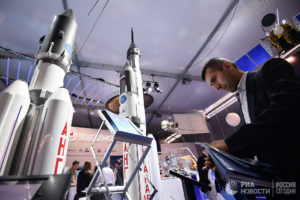
According to Alexander Medvedev, the chief designer of launch vehicles, deputy general director of the TsNIIMash rocket and spacecraft scientific center, and one of the ideologists of the Angara rocket, the Angara-A5B heavy-lift launch vehicle can be modified to be reusable, with landings performed using landing legs similar to those of SpaceX’s Falcon 9 rocket’s reusable first stage.
‘Specific proposals are to return the whole cluster of the first stage and the second stage using rocket dynamics during the launch of Angara-A5B and Angara-A3B launch vehicles’, Medvedev pointed out in his article published in the journal of Central Research Institute of Machine Building ‘Cosmonautics and Rocket Science’.
According to Medvedev, after the launch, the cluster of the first and second stages (the four side blocks of the first stage and the central block or the second stage) would continue to fly without separating until the third stage with the spacecraft separated from them. Then the third stage would continue the flight according to the program. The cluster would turn around with a retrorocket burn and fly with the engines down. Before landing, the central unit would perform a retro burn and the rocket would land on its legs, like the Falcon 9 rocket operated by SpaceX.
According to Medvedev’s calculations, development of the reusable version of the Angara would require changes to its design: it would have to be fitted with landing legs, a control system for landing as well as additional heat-shielding systems. This would increase the mass of the rocket by 12 percent. Furthermore, the landing would require about seven percent of the fuel to be carried by the launch vehicle. The modified version of Angara-A5B would be able to put into orbit 26-27 tons of payload if launched from the Vostochny Cosmodrome. The disposable version would put into orbit 37 tons of payload.
The concept considers reusable versions only for the Angara-A5B and Angara-A3B launch vehicles. Their third stage would require a hydrogen engine that would increase its payload capacity. According to Medvedev, this should compensate for the rocket’s reduced load capacity due to its reusability.
It is suggested to land the stages on a spaceport drone ship in the Sea of Okhotsk at the distance of 1,360 kilometers from the cosmodrome. If reusable Angara stages landed at the launch site, Vostochny Cosmodrome, its load capacity would drop by 40-50 percent from the potentially possible 37 tons, Medvedev said.
‘After landing on the landing site (a ground platform or a floating platform), located in the direction of the route, the cluster of stages undergo the primary post-flight maintenance, and after that they are transported to the area of the Vostochny Cosmodrome to be prepared for the next launch’, the article says.
In the reusable version of the launch vehicle, the cost of launching cargo into a low orbit (200 kilometers) may be reduced by 33-37 percent, and launching to the geostationary orbit (36,000 kilometers) by 22-27 percent.
‘It is worth noting that by reducing the unit cost of a rocket launch we may get a noticeable economic effect in the future, with launches both in the national interest and in the interest of commercial customers’, Medvedev wrote.
 SpaceWatch.Global An independent perspective on space
SpaceWatch.Global An independent perspective on space




